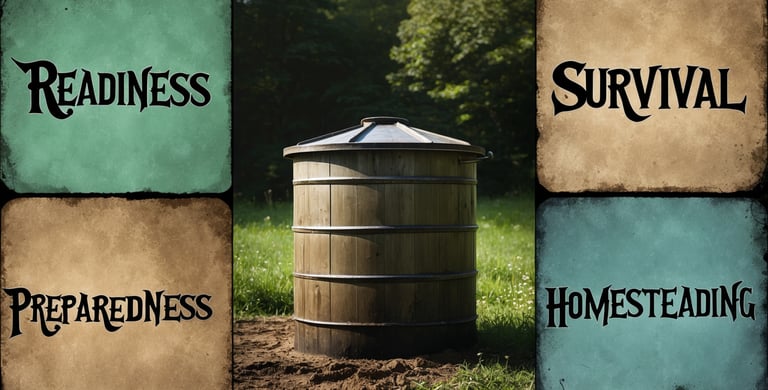Homesteading: Waste and Sanitation
Managing Human and Material Waste on the Autonomous Homestead
4FORTITUDER - READINESS, SURVIVAL, PREPAREDNESS, HOMESTEADING
Homesteading: Waste and Sanitation
Managing Human and Material Waste on the Autonomous Homestead
“Where waste is unchecked, dignity dies. Where cleanliness is preserved, order reigns.”
— 4FORTITUDE Survival Maxims
A Man is Measured by How He Handles His Mess
In a grid-down world, the toilet doesn’t flush, the trash doesn’t get picked up, and the rain carries sickness into the soil. Most preppers think about water and food—but forget the filth. And the result? Cholera. Rats. Depression. Decline.
Sanitation is not optional. It is civilization at its core. And on a homestead, it’s a matter of quiet discipline and engineering grace.
This is not about survival—it’s about sustained sovereignty through stewardship.
Core Knowledge Foundation: The Four Waste Management Mandates
Human Waste Control – Safe, odor-free, disease-proof disposal.
Greywater and Hygiene Flow – Cleaning water that doesn’t poison land.
Material and Household Waste Cycles – Nothing wasted, everything useful.
Disease Prevention, Vermin Control, and Cleanliness Culture – Health is kept by daily habits, not heroics.
Misconception Warning: Sanitation isn’t “figure it out later.” One mistake can poison your food, water, and morale for months.
1. Human Waste Control
Goal: Eliminate pathogens, odor, and runoff—safely and repeatably.
Options by Context:
Composting Toilet System:
Urine and feces separated = less smell + faster breakdown
Layer with sawdust or coconut coir after each use
Store waste in sealed barrels or compost bins, cure 6–12 months before using on non-edible crops
Bucket + Sawdust Toilet (DIY):
5-gallon bucket + toilet seat
Line with compostable bag or dump daily into covered pit
Add sawdust, ash, or leaves after each use
Outhouse:
Pit at least 3 ft deep, 200 ft from any water source
Lime or ash after use
Rotate pits annually or cap and reseed
Drill: For 48 hours, use a dry composting or bucket toilet system. Track odor, routine, and waste management effort. Refine your build.
2. Greywater and Hygiene Flow
Goal: Reuse water without breeding illness or poisoning your soil.
Greywater Includes:
Dishwashing
Bath and shower
Laundry
Reclaim Strategy:
Use natural soaps only (biodegradable)
Divert water to mulch pits or gravel basins for filtration
Irrigate fruit trees, bushes, or non-edible crops
Hygiene Practices:
Handwash stations at every work zone (garden, coop, butchery)
2-bin dishwashing: one wash (hot + soap), one rinse (bleach or vinegar)
Shower: 1 gallon camp showers, sponge baths, solar-heated barrels
Drill: Capture and redirect 5 gallons of greywater daily for one week. Use it for plant irrigation. Test for drainage, smell, and runoff.
3. Material and Household Waste Cycles
Goal: Close loops. Turn “trash” into input.
Organic Waste:
Compost all vegetable scraps, coffee grounds, eggshells
Feed extras to chickens, rabbits, or worms
Turn bones into broth, then grind into garden calcium powder
Inorganic Waste:
Metal → tools or repairs
Glass → reuse for jars, dry storage
Plastic → avoided when possible, reused as seed trays, bins, funnels
Burn or Bury:
Burn paper/cardboard waste
Bury deep any contaminated material (used oil, chemical plastics)
Drill: Track all your household waste for 7 days. Categorize by recyclable, burnable, compostable, and unavoidable. Reduce each by 25%.
4. Disease Prevention, Vermin Control, and Cleanliness Culture
Goal: Maintain not just health—but dignity and morale.
Prevention Systems:
Hand sanitizer + soap at all entry points
Clean tools weekly, especially after meat or garden work
Boil rags and linens monthly
Vermin Control:
Store all feed in metal bins
Use natural deterrents: peppermint oil, bay leaves, cats
Build tight compost bins + regularly rotate to reduce rodent draw
Mindset Discipline:
Establish “clean zone” and “waste zone”
Weekly deep clean: rotate tools, scrub surfaces, air fabrics
Assign rotating chores to train responsibility
Drill: Simulate 1 week without trash pickup or plumbing. Create a complete management plan for waste, cleaning, and pest response. Implement fully.
Advanced Insights: The Hidden Strength of Sanitation
Cleanliness is not about being tidy—it’s about preserving morale under pressure. When collapse drags on, filth becomes psychological rot. Disease breaks the body. But filth breaks the will.
Clean hands, clean tools, and clean hearts win wars more than brute strength alone.
Historical Anchor:
During the trench warfare of WWI, soldiers with better sanitation systems had higher survival rates—not because they fought better, but because they suffered less dysentery, lice, and infection. Sanitation was the unseen sword.
Critical Perspectives: “It’s Not Worth Worrying About”
Adversarial Viewpoint:
“In real collapse, who cares if it’s clean? Just survive.”
Response:
That’s the excuse of the weak man right before his daughter gets sick. Survival is not sloppiness. It's sacred stewardship. Disease is a sniper—and it feeds on ignorance.
Wisdom and Warning Duality
When Followed: You stay healthy, proud, alert. Your family rests easier.
When Ignored: You lose strength to diarrhea. You bury the weak. You let rot reign in your realm.
Strategic Crossroad: Will your homestead stink with survival… or stand as a model of ordered endurance?
Final Charge & Implementation
Brother, this is not the “ugly part” of survival. It is the invisible backbone of sovereignty. Waste must be managed with the same reverence you show food, fire, and faith.
Start Now:
Build the 4-Tier Sanitation Sovereignty Plan
“He who governs waste governs wellness.”
Composting toilet or bucket system
Greywater plan for cleaning and plants
Trash audit and closed-loop redesign
Weekly sanitation + vermin control rhythm
Conduct the Dignity Under Dirt Challenge
“Cleanliness is quiet command.”
No flush toilets for 72 hours
Use only water you filter or heat
Rotate daily cleaning chores
Record health, mood, and logistics of the home
Strategic Reflection:
If you lost plumbing and garbage pickup today… how long before your home smelled like surrender?
Existential Challenge:
Are you the kind of man who rises above filth—or waits for it to remind you you’ve failed?
Manage the mess. Reclaim the rhythm. And build a homestead that doesn’t just feed or power—but preserves dignity, health, and command.


